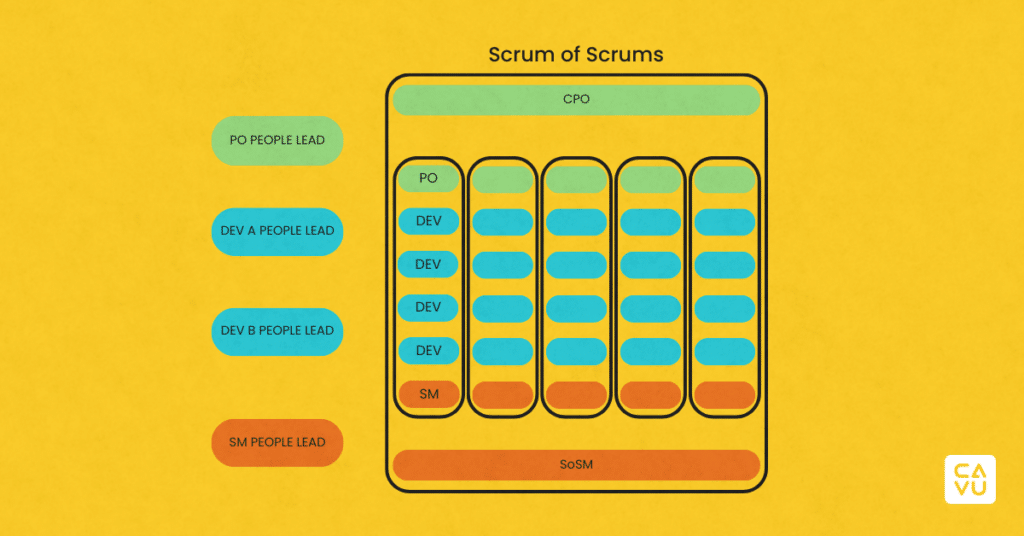What are the Roles in Scrum@Scale?
While Scrum@Scale inherits much from traditional Scrum, it introduces nuances and roles that are key to its successful implementation in a larger, more complex environment. Understanding these roles is crucial for anyone looking to effectively adopt and adapt Scrum@Scale within their organization. Let’s explore some of these pivotal roles, including the Scrum of Scrums Master, Chief Product Owner along side an often-utilized, but unofficial leadership role which I’ve frequently used in my own transformation efforts with Scrum@Scale – People Leads. We will also discuss the vital role of Stakeholders within the Scrum@Scale ecosystem. We hope to equip you with the knowledge needed to navigate and implement these roles within your own organization.
The Scrum of Scrums Master
The Scrum of Scrums Master is pivotal in the Scrum@Scale framework, effectively acting as the linchpin for multiple Scrum Teams working in tandem. This role is akin to a Scrum Master but operates at a broader scale, focusing on ensuring that the collaboration and execution across multiple teams are seamless and effective.
Responsibilities:
- Coordination and Facilitation: The Scrum of Scrums Master is responsible for facilitating the Scrum of Scrums events, where representatives from each Scrum Team come together to discuss progress, impediments, and coordination issues.
- Impediment Removal: A significant part of this role is to identify and remove impediments that may hinder the progress of multiple teams, ensuring a smoother path to achieving Sprint Goals.
- Cross-Team Alignment: This role involves ensuring that all teams are aligned in terms of goals, timelines, and Scrum practices. The Scrum of Scrums Master works to create a cohesive environment where teams can effectively collaborate and share resources.
- Reporting and Transparency: Ensuring transparency and clear communication across teams and to the broader organization, including stakeholders and leadership, is a key responsibility.
Dual Roles: It’s common in Scrum@Scale for the Scrum of Scrums Master to also be a Scrum Master for one of the teams within the Scrum of Scrums. This dual role requires a careful balance to ensure that both team-level and multi-team responsibilities are met effectively.
The Chief Product Owner
The Chief Product Owner (CPO) in Scrum@Scale is a role that scales the traditional responsibilities of a Product Owner across multiple teams. The CPO is tasked with ensuring that the product vision and goals are consistently represented and understood across all teams in the Scrum of Scrums.
Responsibilities:
- Vision and Strategy Alignment: The Chief Product Owner is the custodian of the product vision, aligning multiple teams to a common goal. They ensure that the overall strategy is clear and communicated effectively to all Product Owners within the Scrum of Scrums.
- Backlog Prioritization and Management: A key responsibility is to oversee the creation and prioritization of the product backlog at a scale that encompasses all teams in the Scrum of Scrums. The CPO frequently meets with the Product Owners from each team and ensures that backlogs are aligned and that dependencies and conflicts are managed efficiently.
- Facilitation of MetaScrum Events: The CPO often leads MetaScrum events, a forum where Product Owners and stakeholders collaborate to prioritize and review the work of multiple Scrum Teams within a Scrum of Scrums.
Dual Roles: Similar to the Scrum of Scrums Master, the Chief Product Owner may also function as a Product Owner for one of the Scrum Teams. This duality requires adept management skills to balance team-specific product needs with the broader organizational product goals.

People Leads: Focusing on Specialist Development
Though not directly covered in the current version of the Scrum@Scale guide, the role of People Leads is often a necessary element to focus on the development of people within the organization. These leads play a crucial role in fostering communities of practice and ensuring that there is a coherent strategy for the development of specific skill sets across the organization.
Key Responsibilities:
- Community Building: People Leads are responsible for organizing and leading communities of practice. These communities provide a platform for individuals with similar skills or roles, such as testers or support personnel, to share knowledge, discuss challenges, and develop best practices.
- Skill Development: They focus on the continuous development of their team members’ skills, ensuring that they are up-to-date with the latest trends and technologies in their respective areas.
- Strategic Input: People Leads contribute to the overall strategy of how certain functions, like testing or customer support, are conducted within the organization. They ensure that these strategies align with the overall goals of the organization and the needs of the Scrum Teams.
- Cross-Team Collaboration: While team members might be part of cross-functional teams, People Leads ensure that there is a unified approach and shared learning across different teams for specific functions.
Impact on Scrum@Scale Implementation:
People Leads play a vital role in ensuring that while teams are cross-functional and self-organizing, there is still a coordinated approach to developing and sharing specialist knowledge. This role helps maintain a balance between team autonomy and organizational coherence.
The Role of Stakeholders in Scrum@Scale
For a Scrum Team, a “stakeholder” is not a formal “role”, but a term that refers to an individual outside the immediate Scrum Teams who have a vested interest in the outcomes of the work the team is doing. These stakeholders typically include business leaders or other key parties impacted by the product’s development. In Scrum@Scale, the role of stakeholder is crucial for the framework’s success. Stakeholders have a significant impact on the trajectory of the Scaled teams through their participation in various events and their ongoing engagement with the Scrum process. Just because a particular leader is not a part of one of a Scrum of Scrums, does not mean they are not able to significantly impact and guide the work of those teams.
Key Involvements:
- Participation in Reviews: Stakeholders attend Sprint Reviews to provide feedback on the product increments. Their insights and feedback are vital in guiding the development teams in the right direction.
- Engagement in MetaScrum Events: Stakeholders actively participate in MetaScrum events. This involvement is crucial for aligning the team’s work with the broader organizational goals and for making pivotal decisions regarding the product backlog. By being actively involved, stakeholders can influence the product development process, ensuring that the team’s work aligns with market needs and organizational objectives.
Importance of Stakeholder Engagement:
The engagement of stakeholders is essential in Scrum@Scale as it ensures that the work of the Scrum Teams is closely aligned with the needs of the business and the expectations of the customers. Their participation helps in making Scrum@Scale a collaborative and adaptive process, driving value and efficiency throughout the department.
Using the Roles for a Successful Scrum@Scale Transformation
Scrum@Scale offers a dynamic and collaborative framework for scaling Scrum across multiple teams. These scaled roles, each with their distinct responsibilities and contributions, collectively drive the success of Agile practices across teams, aligning efforts with organizational goals and market demands. As we have seen, the key to effective Scrum@Scale implementation lies not only in the processes and methodologies but also in the people who drive them. At CAVU, we encourage leaders and team members alike to recognize the value of these roles and integrate them into their Scrum@Scale journey for enhanced collaboration, innovation, and overall business agility.








